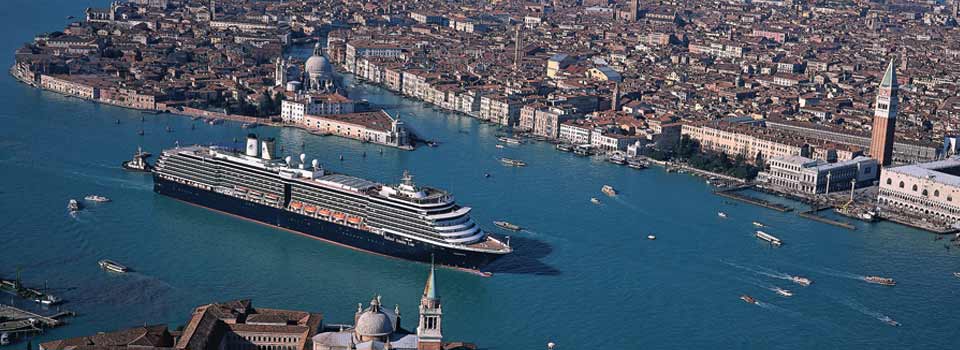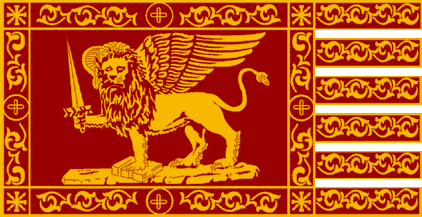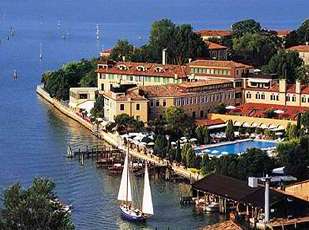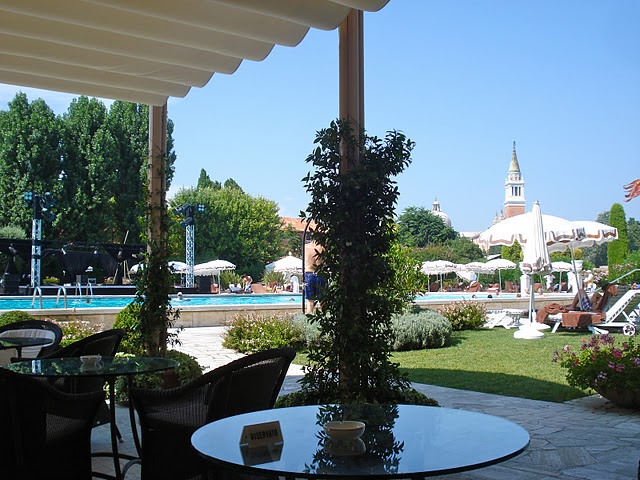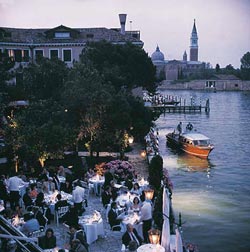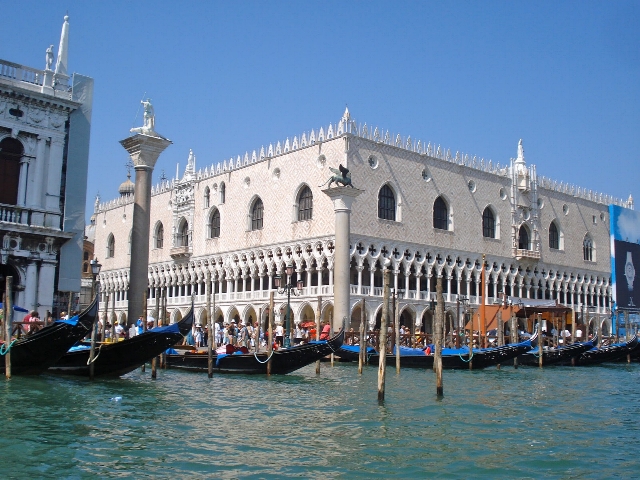|
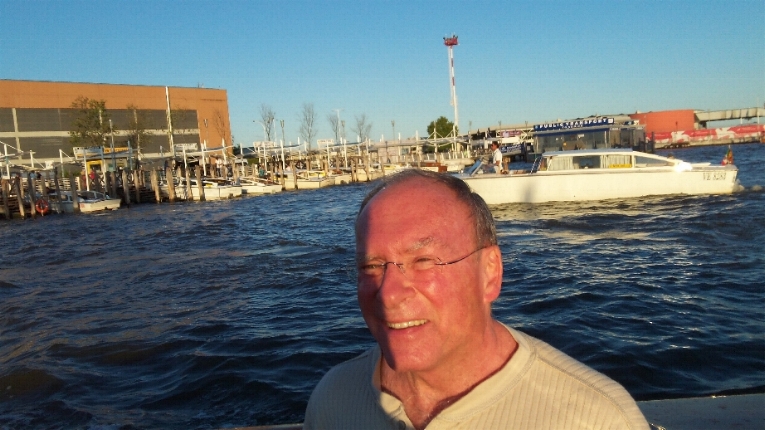
Boden's big smile indicates arrival in Venice
after the long flight, ready to take the water taxi to our hotel. |
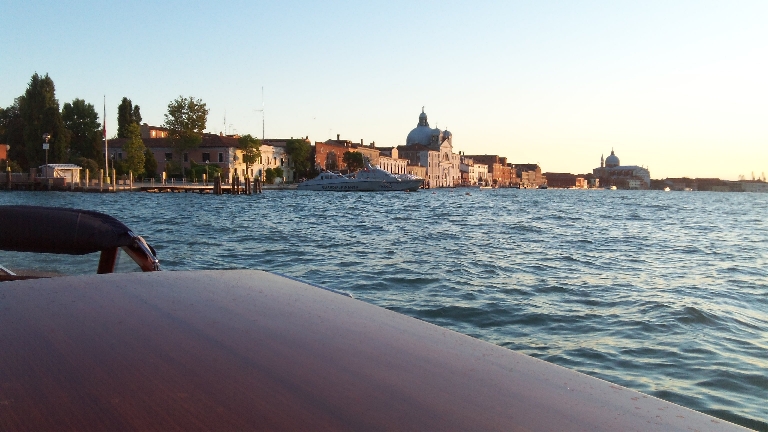
Approaching our
hotel.

|

Hotel
suite's "breakfast room".
One of those windows is actually a patio door
leading to our private terrace.
We had breakfast on the terrace one day
instead of the buffet breakfast in the garden. |

San Giorgio
Maggiore, seen in many photos of Venice. This beautiful church was designed
by Palladio (1566).
We passed very close by this building at least twice a
day on our route between the hotel and San Marco.
It is on its own island.
You will see this church in the following photo looking back from San Marco.
|

Doge's Palace
(Palazzo Ducale) and the two famous columns at the entrance to San Marco,
the columns of San Marco and San Teodoro.
The palace was the residence
of the Doge of Venice, the supreme authority of the Republic of Venice.
One
source says the two columns were brought from Constantinople and erected in the
12th century.
Another source says the columns came from Tyre (now in the
Lebanon) in 1125 and there were 3 columns,
one of which sunk to the bottom
of the Venetian lagoon as it was being unloaded.
The Venetians topped one
columns with a statue of San Teodoro, the patron of Venice before San Marco.
The second column was topped with a bronze lion with wings, a symbol of
Venice. (See flag above.)
360
view adjacent to the Doges Palace looking across to the island where
our hotel is located |
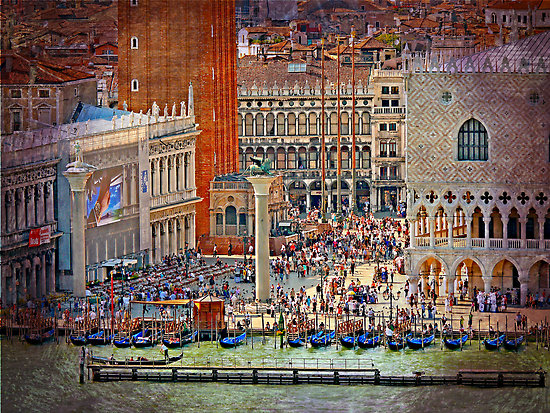
I love this artwork that shows the Piazza San Marco,
the Doges Palace, and the columns so well |

a
Doge's Palace detail that caught my eye |

The
facade of San Marco at sunset. The basilica is one of the best examples of
Byzantine architecture in the world.
It was started in 1081 and completed in
1617. |

I
like this shot of Boden in the center of Piazza San Marco.
Odd, but there
were surprisingly few pigeons there this time. Yay! |

"The
Tetrarchs", a charming exterior sculpture, has an interesting history.
In an
attempt to stabilise the Roman Empire after the crisis of the third
century,
the Emperor Diocletian (who will come up later in this trip)
imposed a new Imperial structure:
a four co-emperor ruling plan called
The Tetrarchy. This porphyry statue represents the
inter-dependence of the
four rulers. It was taken from Constantinople, during the Fourth Crusade in
1204,
and set into the southwest corner of the basilica at eye level. |

Detail
showing the ornamentations at the pinnacle of San Marco's facade |
360 views of Piazza San
Marco
Piazza
View 1 - showing the basilica, bell tower, and complete plaza with its
restaurants and arcade filled with expensive shops
Piazza
View 2 - We had noontime drinks at this restaurant in the piazza, the
famous Cafe Florian:
While we were there, there was an orchestra playing in
the bandstand. |
I took this unique shot of the Campanile from under the
arcade of the Procuratie Nuove (the buildings
on 3 sides of the piazza). I
used the camera's sepia setting. |

Santa Maria della
Salute (finished 1681) is another one of those churches you see in many
photos of Venice.
I just noticed it appears in all 3 of my section header
photos above. |

The
Grand Canal is the busy waterway that snakes through the heart of Venice.
I
took this photo from the top floor of the
Ca d'Oro ("Golden
House"), a beautiful palazzo,
so-called because it used to be have gilt
adornments on the exterior. |
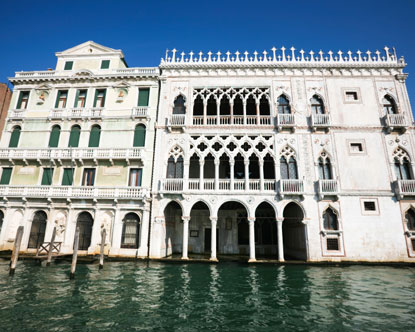
Ca’ d’Oro is widely considered to be the most
beautiful of all the palazzi that line the Grand Canal in Venice.
Its proper
name is Palazzo Santa Sofia. It is not only one of the most visually stunning
of all the palazzi in Venice
with its ornate façade, but also one of
the oldest, having been constructed between 1428 and 1430 |


The
Venetian Arsenal
(Arsenale di Venezia) is off the beaten path, but we ended up here
by fortunate mistake.
The Arsenal was responsible for Venice's dominance in
the Mediterranean, being the shipbuilding and arms manufacturing centre. The
Arsenal was the largest manufacturing complex in Europe prior to the Industrial
Revolution.
The photo shows the Porta Magna (Main Gate), built around 1460,
the first Classical revival structure built in Venice. |

Close-up
of the statues at the Porta Magna |

We
attended 2/3 of a performance of La Traviata at the opera house, Il
Teatro de Fenice .
"Fenice" means "phoenix". After burning and being
rebuilt a number of times, it was renamed "Phoenix".
Then the theatre
burned down again... twice.
The most recent fire was in 1996, so the
current theatre dates from 2001.
By the way, the opera we saw was terrible,
a modern treatment with minimalist set design. What a disappointment!
We
should have just taken a tour of the beautiful opera house which is new but
appears much as it did in the 19th Century when Verdi debuted La
Traviata here. |

After
the opera, we went next door for a wonderful meal here at Antico
Martini.
(The white columns in the background are part of the portico of the
opera house.) |

I ran across this plaque to the
(re)discovery of Newfoundland by the explorer John Cabot,
a citizen of the
Venetian Republic whose real name was probably Giovanni Caboto.
Like
Christopher Columbus (another Italian), his name was anglicized. |
|
